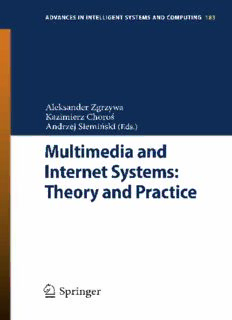
Multimedia and Internet Systems: Theory and Practice PDF
Preview Multimedia and Internet Systems: Theory and Practice
Advances in Intelligent Systems and Computing 183 Editor-in-Chief Prof.JanuszKacprzyk SystemsResearchInstitute PolishAcademyofSciences ul.Newelska6 01-447Warsaw Poland E-mail:[email protected] Forfurthervolumes: http://www.springer.com/series/11156 Aleksander Zgrzywa, Kazimierz Choros´, and Andrzej Siemin´ski (Eds.) Multimedia and Internet Systems: Theory and Practice ABC Editors AleksanderZgrzywa AndrzejSiemin´ski InstituteofInformatics InstituteofInformatics WrocławUniversityofTechnology WrocławUniversityofTechnology Wrocław Wrocław Poland Poland KazimierzChoros´ InstituteofInformatics WrocławUniversityofTechnology Wrocław Poland ISSN2194-5357 e-ISSN2194-5365 ISBN978-3-642-32334-8 e-ISBN978-3-642-32335-5 DOI10.1007/978-3-642-32335-5 SpringerHeidelbergNewYorkDordrechtLondon LibraryofCongressControlNumber:2012943389 (cid:2)c Springer-VerlagBerlinHeidelberg2013 Thisworkissubjecttocopyright.AllrightsarereservedbythePublisher,whetherthewholeorpartof thematerialisconcerned,specificallytherightsoftranslation,reprinting,reuseofillustrations,recitation, broadcasting,reproductiononmicrofilmsorinanyotherphysicalway,andtransmissionorinformation storageandretrieval,electronicadaptation,computersoftware,orbysimilarordissimilarmethodology nowknownorhereafterdeveloped.Exemptedfromthislegalreservationarebriefexcerptsinconnection with reviews or scholarly analysis or material supplied specifically for the purpose of being entered and executed on a computer system, for exclusive use by the purchaser of the work. Duplication of this publication or parts thereof is permitted only under the provisions of the Copyright Law of the Publisher’slocation,initscurrentversion,andpermissionforusemustalwaysbeobtainedfromSpringer. PermissionsforusemaybeobtainedthroughRightsLinkattheCopyrightClearanceCenter.Violations areliabletoprosecutionundertherespectiveCopyrightLaw. Theuseofgeneraldescriptivenames,registerednames,trademarks,servicemarks,etc.inthispublication doesnotimply,evenintheabsenceofaspecificstatement,thatsuchnamesareexemptfromtherelevant protectivelawsandregulationsandthereforefreeforgeneraluse. Whiletheadviceandinformationinthisbookarebelievedtobetrueandaccurateatthedateofpub- lication,neithertheauthorsnortheeditorsnorthepublishercanacceptanylegalresponsibilityforany errorsoromissionsthatmaybemade.Thepublishermakesnowarranty,expressorimplied,withrespect tothematerialcontainedherein. Printedonacid-freepaper SpringerispartofSpringerScience+BusinessMedia(www.springer.com) Preface Duringthelast20yearswehavewitnessedarapiddevelopmentofMultimediaand Network Information Systems. What is even more important, the pace of change doesnotshowanysignofslowing.Whenwelookbackweseehowmanyresearch projectsthathaveoriginatedatuniversitiesorinresearchfacilitiesnowarepartof oureverydaylife.Thiscallsforavolumethataddressesthecapabilities,limitations, currenttrendsandperspectivesofMultimediaandNetworkInformationSystems. Our intention is to offer the readers of this monographa very broad review of therecentscientificproblemsinthatarea.Solvingthemhasbecameaprincipaltask of numerousscientific teams all overthe world.The volume is a selection of rep- resentativeinvestigations,solutionsand applicationssubmittedby scientific teams workinginmanyEuropeancountries. Contentofthebookhasbeendividedintofourparts: IMultimediaInformationTechnology IIInformationSystemSpecification IIIInformationSystemApplications IVWebSystemsandNetworkTechnologies PartIcontainseightchaptersthatdiscussesnewmethodsofvisualdataprocess- ing.Thestudiesandresultingsolutionsdescribedintheseveralchaptersofthispart followthegainingmomentumtrendofexploitingartificialintelligencetechniques, fuzzy logic, multi-agent approaches in the domain of multimedia information technology.Thedomaincoversimagealignment,videodeinterlacing,cartographic representation,visual objects description,large scale 3D reconstruction,and hand gesture recognition.Two of the chaptersfocus on the content-basedindexing and retrievalofvisualdata. The second part of the book consists of seven chapters. Two of them address thespecificproblemsofdifferentapplicationsofontology’sininformationsystems andthe ontologyalignment.Thispartalso containsreportsonthe experimentson the evaluation of re-sampling combined with clustering and random oracle using geneticfuzzysystemsandthestudyofparameterselectionfortheDynamicTrav- elling Salesman Problem. One of the chapters deals with the modelingfailures of VI Preface distributed systems in stochastic process algebras. The importantfrom a practical pointofviewproblemoftrackingchangesindatabaseschemasisalsodiscussedin thelastchapterofthispart. Part III presents a handful of applications. It consists of four chapters. One of them describes an adaptive e-learning application with a catchy name of Power Chalk. Innovative solutions to the problem of unified user identification for mo- bile environmentsand smart communicationsfor remote users are also discussed. Thelastchapterpresentsarulebasedexpertsystemthatcoverssemanticmatching, spatiotemporal relation operators, and comparison of GIS data to eliminate VAT- carouselcrimes. PartIVreferstothetrendsandperspectivesinWebSystemsandNetworkTech- nologies. It contains 6 chapters. Two of them deal with e-commerce issues dis- cussingtheevaluationoftheserverperformanceandpresentinganapproachtouse productreviewsfrome-commercewebsitesfortheproductfeatureopinionmining task. The usefulness of Web pages can considerably suffer from poor readability. Therefore a special chapter is devoted to a methodology of creating a computer aided system for measuring text readability. Finding relevant services from a ser- vicecollectionisyetanotherimportantaspectoftheWebTechnologies.Twoofthe chaptersinthispartaredevotedtotheproblem. Thebookshouldbeofgreatinteresttoresearchersinvolvedinallaspectsofmul- timediaandInternetapplications.Wehopethatitwillfulfilltheexpectationsofits readers and we will be also very pleased if the book will attract more scholars to workontheareaandtoinspiretheresearchcommunityalreadyworkingonthedo- main.Ifso,thegoalthatmotivatedauthors,reviewers,andeditorswillbeachieved. Itwillbealsothegreatestprizeforourjointefforts. AleksanderZgrzywa KazimierzChoros´ AndrzejSiemin´ski Contents PartI: MultimediaInformationTechnology 1 FuzzyRule-BasedClassifierforContent-BasedImageRetrieval.... 3 TatianaJaworska 1.1 Introduction .............................................. 3 1.2 Fuzziness ................................................ 5 1.2.1 FuzzySets......................................... 5 1.2.2 FuzzyRule-BasedClassifiers ......................... 5 1.3 GraphicalDataRepresentation .............................. 7 1.4 ClassificationResults ...................................... 8 1.5 FurtherUseofClassifiedObjectsinCBIR..................... 11 1.6 Conclusions .............................................. 11 References.................................................... 12 2 DecentralizedMulti-Agent Algorithmfor Translational2D ImageAlignment.............................................. 15 TomášMachálek,KamilaOlševicˇová 2.1 Introduction .............................................. 15 2.2 ProblemStatement ........................................ 17 2.3 ProposedSolution......................................... 17 2.4 EstimationofComputationalComplexity ..................... 21 2.5 Experiments.............................................. 21 2.6 Conclusions .............................................. 23 References.................................................... 24 3 ASparseReconstructionApproachtoVideoDeinterlacing ........ 25 MariaTrocan 3.1 Introduction .............................................. 25 3.2 Background .............................................. 27 3.3 ProposedMethod.......................................... 28 3.4 ExperimentalResults ...................................... 30 3.5 Conclusion............................................... 32 References.................................................... 32 VIII Contents 4 CartographicRepresentationofRouteReconstructionResultsin VideoSurveillanceSystem ..................................... 35 KarolLisowski,AndrzejCzyz˙ewski 4.1 Introduction .............................................. 35 4.2 RelatedWork............................................. 36 4.3 ProposedMethod.......................................... 36 4.3.1 TopologyofCameraNetwork......................... 36 4.3.2 ObtainingContextualData ........................... 37 4.3.3 ArchitectureoftheSystem ........................... 38 4.3.4 AugmentingCartographicData ....................... 39 4.4 Results .................................................. 40 4.5 Conclusion............................................... 42 References.................................................... 43 5 Visual Objects Description for Their Re-identification in Multi-CameraSystems ........................................ 45 DamianEllwart,AndrzejCzyz˙ewski 5.1 Introduction .............................................. 45 5.2 ObjectTracking........................................... 47 5.2.1 SingleCameraObjectTracking ....................... 47 5.2.2 Multi-CameraObjectTracking........................ 47 5.3 ObjectDescriptionMethods................................. 48 5.4 Experiments.............................................. 49 5.4.1 DatasetPreparation ................................. 50 5.4.2 FeatureEvaluation .................................. 51 5.5 Summary ................................................ 53 References.................................................... 53 6 CompactDescriptorforVideoSequenceMatchingintheContext ofLargeScale3DReconstruction............................... 55 RomanParys,FlorianLiefers,AndreasSchilling 6.1 Introduction .............................................. 55 6.2 RelatedWork............................................. 56 6.3 CompactDescriptorandMatching ........................... 57 6.3.1 ComputationofCompactDescriptor ................... 57 6.3.2 ComputationofSimilarityMeasure ................... 58 6.3.3 ComputationofImageOccurrenceStatistics ............ 59 6.3.4 ComputationofMatchingFrames ..................... 60 6.4 Results .................................................. 61 6.5 ConclusionsandFutureWork ............................... 63 References.................................................... 64 7 HeadlinesUsefulnessforContent-BasedIndexingofTVSports News ........................................................ 65 KazimierzChoros´ 7.1 Introduction .............................................. 65 Contents IX 7.2 RelatedWorks ............................................ 67 7.3 BookStructurevs.TVSportsNewsStructure.................. 67 7.4 AVI-AutomaticVideoIndexer.............................. 70 7.5 StructureofTVSportsNews................................ 70 7.6 HeadlinesinTVSportsNews ............................... 72 7.7 FinalConclusionsandFurtherStudies ........................ 74 References.................................................... 75 8 Examining Classifiers Applied to Static Hand Gesture RecognitioninNovelSoundMixingSystem ...................... 77 MichalLech,BozenaKostek,AndrzejCzyz˙ewski 8.1 Introduction .............................................. 77 8.2 SystemOverview ......................................... 78 8.3 ExaminingClassifiersPerformance........................... 80 8.3.1 Tests.............................................. 80 8.3.2 Results............................................ 81 8.4 Conclusions .............................................. 85 References.................................................... 85 PartII: InformationSystemsSpecification 9 MultipleDataTablesProcessingviaOne-SidedConceptLattices ... 89 PeterButka,JozefPócs,JanaPócsová,MartinSarnovský 9.1 Introduction .............................................. 89 9.2 PreliminariesonOne-SidedConceptLattices .................. 90 9.3 ClosureOperatorDefinedbyMultipleDataTables.............. 93 9.4 Conclusions .............................................. 97 References.................................................... 98 10 A Multi-attributeandLogic-BasedFrameworkofOntology Alignment.................................................... 99 MarcinPietranik,NgocThanhNguyen 10.1 Introduction .............................................. 99 10.2 BasicNotions............................................. 101 10.3 Attribute-BasedConceptAlignment.......................... 102 10.4 RelatedWorks ............................................ 103 10.5 EvaluationMethodology ................................... 104 10.6 SummaryandFutureWorks................................. 107 References.................................................... 108 11 Application of an Ontology-BasedModel to a Wide-Class FraudulentDisbursementEconomicCrimes ..................... 109 CzesławJe˛drzejek,JarosławBa˛k 11.1 Introduction .............................................. 109 11.2 TheModel ............................................... 111 11.3 SetofRules .............................................. 113 X Contents 11.4 Queries.................................................. 116 11.5 Conclusions .............................................. 116 References.................................................... 117 12 ModellingFailuresofDistributedSystemsinStochasticProcess Algebras ..................................................... 119 JerzyBrzezin´ski,DariuszDwornikowski 12.1 Introduction .............................................. 119 12.2 BasicDefinitions.......................................... 121 12.2.1 StochasticProcessAlgebras .......................... 121 12.2.2 BasicFailuresinDistributedSystems .................. 121 12.3 ModellingFailures ........................................ 122 12.3.1 Crash-RecoveryFailures ............................. 123 12.3.2 Crash-StopFailureModels ........................... 124 12.3.3 OmissionModel.................................... 126 12.3.4 ModellingFailureDetectors .......................... 127 12.4 Conclusions .............................................. 128 References.................................................... 129 13 Experimental Evaluation of Resampling Combined with ClusteringandRandomOracleUsingGeneticFuzzySystems ...... 131 TadeuszLasota,ZbigniewTelec,BogdanTrawin´ski,GrzegorzTrawin´ski 13.1 Introduction .............................................. 131 13.2 MethodsUsedinExperiments............................... 133 13.3 ExperimentalSetup........................................ 136 13.4 ExperimentalResults ...................................... 137 13.5 Conclusions .............................................. 140 References.................................................... 141 14 AntColonyOptimizationParameterEvaluation.................. 143 AndrzejSiemin´ski 14.1 Introduction .............................................. 143 14.2 BasicACOAlgorithmforStaticTSP ......................... 144 14.2.1 ACOBasicOperations............................... 145 14.2.2 ParameterSelection ................................. 146 14.3 DynamicTSP............................................. 146 14.3.1 RelatedWork ...................................... 147 14.3.2 GraphGenerators................................... 147 14.4 Experiment............................................... 149 14.4.1 DataExploration.................................... 150 14.4.2 CorrelationAnalysis ................................ 151 14.5 Conclusions .............................................. 152 References.................................................... 153
Description: